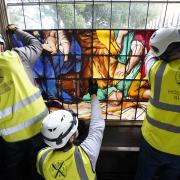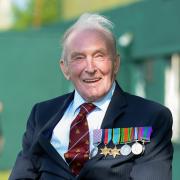We’re all familiar with Hampshire’s most famous monuments and memorials to the World Wars we’ll be commemorating this month, as well as our most important military buildings. But what about the smaller, and less well-known places associated with our Armed Services? asks Faith Eckersall
Portsmouth War Memorial
The soaring, dignified Portland stone obelisk that dominates Southsea Common carries upon it the names of more than 35,000 sailors lost in the First and Second World Wars. Over half of all British personnel lost at Jutland in 1916 – some 3,400 men – are commemorated on the Portsmouth Naval Memorial and, soberingly, similar monuments inscribed with thousands of names also exist at Chatham and Plymouth.
The Admiralty had a heavy hand in the obelisk’s design – it is intended as a marker for shipping as well as a memorial - and it was designed by the architect Sir Robert Lorimer. When the future King George VI unveiled it on October 15 1924, little could he have known that within 30 years his wife, Queen Elizabeth The Queen Mother, would be unveiling the extension built to carry the 15,000 additional names of those who were lost in World War II.
The Portsmouth War Memorial now commemorates more than 24,500 Commonwealth naval servicemen and women and is a Grade 1 Listed structure.
The Secret Fuel Line
The original fuel terminal at Hamble was opened by Shell in 1924. But during World War II it took part in something far more hush-hush - the ambitious Operation PLUTO (Pipeline Under The Ocean) to secretly transport fuel under the Solent and Channel to the Allies for use in the D-Day landings. The pipeline didn’t quite live up to expectations although it’s said that markers of its position can still be found in the area. And many of the buildings used to disguise it are still going today, including several at Browns Golf Course, Sandown, on the Isle of Wight.

World War II Gem
As reminders of the Second World War go, the wonderfully-named Huff Duff must surely be one of the most modest. You’ll find this little octagonal brick gem if you go on the National Trust’s Walking Trail on Ibsley Common in the New Forest.
Its name comes from its purpose, as a HF/DF – essentially the building had a rotating directional aerial mounted on to a tower. Using the information from other Huff Duffs, the one at Ibsley could plot the location of any radio transmitter in the area – vital when keeping track of enemy or Allied movements.
The wooden tower has long gone but the New Forest National Park authority’s site has a CGI of what it would have looked like – and the views from the hill its stands on are worth walking up for.

Churchill’s Siding
It’s a village better known for its walks and its pubs these days but in the early summer of 1944, Droxford was the centre of the entire war effort. How? Because it was to a quiet siding in the Meon Valley village that Prime Minister Winston Churchill chose to meet key players to prep for D-Day.
On June 2 1944 an armoured train carried Churchill and his war cabinet to the quiet siding, just south of the village station, to meet with US General Dwight Eisenhower, French leader Charles de Gaulle, and the Canadian President and the leader of South Africa.
Although described as ‘Top Secret’ villagers soon got wind of the important visitors – perhaps not too difficult as De Gaulle was escorted there on foot by Foreign Secretary Anthony Eden and Churchill was seen to be wandering around in the goods yard. (It’s also rumoured that village children presented him with a basket of strawberries!) The famous siding still exists, with an information board, and the old station can still be glimpsed as a private residence along the Meon Valley Trail.

The People’s Memorial
You have to know where to look to find The People’s Memorial, tucked away on the west side of Langstone Harbour, on Milton Common, facing out to sea. The simple white-stone wall and flagstaff were created by Willie Goldfinch, described on the Memorial’s website as a former Protestant Paramilitary who was sent to prison for terrorist activities. Whilst out running in October 2009, he says he felt ‘driven to create a tangible focus point’ to remind people of the sacrifices made for ‘British freedom and the unique culture that we enjoy today.’ People have felt compelled to add to the memorial ever since.
According to a report from Portsmouth City Council: ‘The memorial is constructed from materials sourced from the shoreline on Langstone Harbour. The original construction consisted of a circular wall of assorted stone material and was susceptible to coastal erosion and potential to become unstable. It has since been rebuilt with a wider base, filled with shingle and haunched on the eastern face.’
Cemetery of Heroes
As cemeteries go, the one on Southsea’s Highland Road, must be one of the UK’s most illustrious, caring, as it does, for the graves of no fewer than eight Victoria Cross holders. Amongst them were Henry James Raby who died in 1907. A Lieutenant with the Navy Brigade at Sebastopol, under heavy Russian gunfire he rescued a wounded soldier.
He was promoted to Commander for his valour and as the most senior officer of the Senior Service at the first investiture of the award, instituted by Queen Victoria, was the first recipient of the VC. Israel Harding VC lived to receive his award, after picking up a huge shell which had pierced the side of the Alexandra, and throwing it in a tub of water. The ‘fine, jovial-looking seaman’ was invested as a VC holder and died in 1917 aged 83.

Southampton’s Blitz
Southampton’s Holyrood Church – built in 1320 and destroyed by the German Airforce in November 1940 – has always been the city’s most visible witness to the horror that was visited on it during the Blitz.
It was one of seven churches deliberately destroyed during this time, with the worst night being November 30. On that night 800 bombs were dropped by the Luftwaffe killing 137 people, including 96 trying to escape the firestorm in air raid shelters. St Michael’s Church escaped - but only because there were orders not to destroy it as its elegant spire was used as a marker by enemy aircraft. Among the victims of these cruel attacks were a Mr Edgar L. Perry, who had survived the sinking of the Titanic but succumbed to Hitler’s bombing.
Perhaps the city’s most grievous loss was during a daylight raid on the Civic Centre Art Gallery. It was claimed that Luftwaffe head Hermann Goering had described the centre as looking like a ‘piece of cake’ from the air and that he was going to ‘cut himself a slice’. His wish came true on November 6 1940 as a 500lb high explosive device penetrated the gallery to the ground floor. It killed 20 adults – and 15 young people who were attending an art lesson in the gallery’s basement.
Over all, Southampton suffered 57 attacks and its people underwent 1,500 air-raid warnings.
Village Hall
Look closely at East Boldre Village Hall - because it’s not quite what it seems! Unlike many of its counterparts, this delightful little building was built in 1917 and 1918 as part of the Royal Flying Corps training airfield and is alleged to have served as the Officer’s Mess during the First World War.
In 1919 the Forestry Commission allowed it to be used as the village hall for, it’s said, an annual rent of one shilling. The hall has played many parts, from cinema, to WI meeting place and as a parish hall, and in World War II it was used as a base by the local Home Guard. Best news of all? It’s still going strong, and can be booked for a variety of events, including canine massage classes!




























